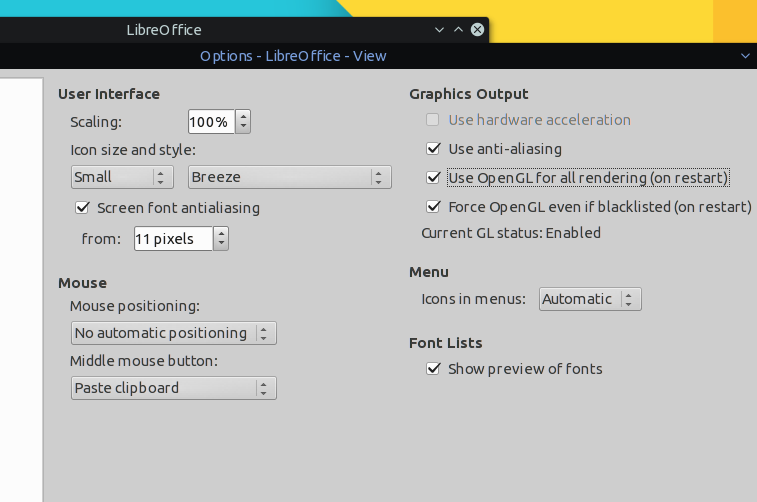Libreoffice Hardware Acceleration
User Interface Graphics Output Scaling: 100% 3. Use hardware acceleration Icon. View options for LibreOffice applications Mouse positioning Specifies if.
The new release of is certainly gaining ground on the much-maligned, but does it have the 'radical innovations' once promised, and will it be a threat to Microsoft's upcoming? That stewards LibreOffice is making bold claims for the new release, and is calling its approach 'aggressive feature development and code renovation'. Version 3.5 shows progress on both fronts, with resulting improvements that range from the obvious to the subtle. Welcome changes include the installer for Windows now being a single MSI file with the Liberation fonts bundled in, and a wizard that lets you pick which dictionary and interface languages you want, rather than a grab-bag of different files and links to deal with manually. You can install it and start working straight away.
LibreOffice finally gets a unified installer for Windows, combining spelling and interface languages, tools and utilities into a single package The first time you run the LibreOffice launcher, a small icon provides a way to check for updates to extensions; the suite also checks for updates regularly, but doesn't download them unless you ask. Small changes like this make LibreOffice feel more professional than OpenOffice ever did.
Top ZDNET Reviews. 8.0 Upgrading is a little trickier though. Annoyingly, unless you have the very recent LibreOffice 3.4.5, you can't upgrade to LibreOffice 3.5: you have to uninstall the version you have and install from scratch (the uninstaller for LibreOffice 3.3 is particularly slow, so set aside some time for this), or upgrade to version 3.4.5 and then to 3.5. If you've been testing the prerelease versions this is the same code as 3.5 RC3, so if you have that you don't need to update. Mac users will probably need to turn off hardware acceleration because this can make some presentations display incorrectly or crash — we did see this with at least one test file.
This is what can happen with the Document Foundation's 'aggressive' feature development, in contrast to the more cautious approach favoured by OpenOffice. Improvements and new features The improvements since The Document Foundation took over the OpenOffice code help to justify that aggressive strategy, as they're significant — especially in a suite that's made little progress in recent years. However, few of the changes will be new to anyone who's used Microsoft Office. For example, in Calc (which now allows 10,000 sheets per workbook) you can click an arrow to expand the input bar from one line to a larger box, as you can in Excel (although it shows six lines of input rather than three). You can also select multiple entries in the Autofilter dropdown for each column to filter what rows you see — very useful, but also familiar to Excel users. In Writer you can leave a dynamic word count open as you write, but it's a large dialogue to have obscuring part of your document Writer gets a very welcome live word count, but you have to leave a large dialogue box open on-screen rather than having it appear in the status bar. You can finally edit headers and footers simply by clicking into them in the Print layout — an interface almost identical to Word 2010, except you can't collapse the grey background between pages to save space.
Similarly, you can now display the paragraph mark that marks a new line by clicking in the toolbar — a feature that's been in Word for many years. The new grammar checker in Writer is less irritating than Word's because it's less ambitious: it sticks to checking common mistakes like spacing, capitalisation, punctuation and duplicate words.
Mastodon crack the skye download. It also works rather slower — you see spelling errors marked almost as soon as you've mistyped them, but a duplicate word might not get highlighted until you've finished a couple more sentences. The idea of editing the grammar rules yourself with an extension is very appealing, but getting the rules right is far from easy. Not new, but still irritating, is the fact that word completion is on by default in Writer. We'd like to see this feature become a user-selected option. Interface questions The LibreOffice interface is based on menus and (many, many) toolbars, the minor freshen-up changes in version 3.5 making the suite feel more consistent between applications than OpenOffice. Document rendering is also improved: enhanced font hinting gives documents a slightly better look, while curves drawn with splines in Impress, Calc (charts) and Draw are now correctly curved rather than having odd straight segments.
